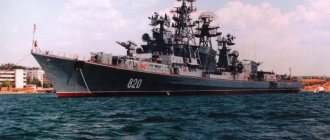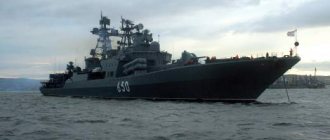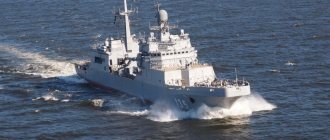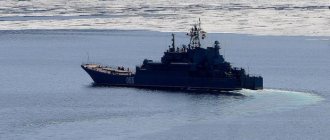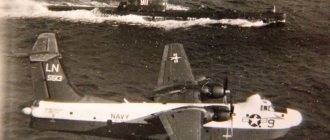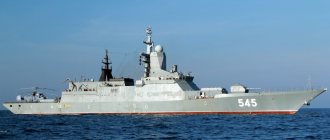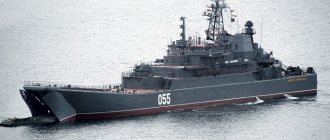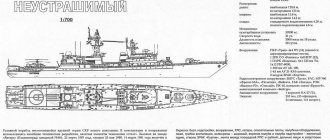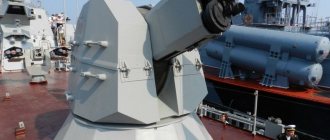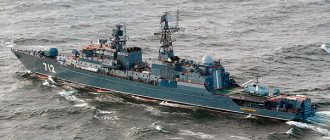Large anti-submarine ships of Project 1134 "Berkut"
An anti-submarine and air defense ship appeared in military shipbuilding plans in 1961, when the construction of Project 58 was already in full swing ( see the author’s previous article >>> ). Formally, the basis for the development of a new project, which received the number 1134 , was the resolution of the Central Committee of the CPSU and the Council of Ministers of the USSR No. 1180-510 dated December 30, 1961. Shortly before the release of this resolution, in the same December 1961, the Main Directorate of Shipbuilding (GUK) of the Navy ordered the Northern Design Bureau to develop a project for an air defense-anti-aircraft defense ship, immediately from the technical design stage, bypassing the draft design, which indicated direct continuity of Project 1134 in relation to Project 58 .
However, the circumstances that led to the appearance of the new ship were not simply a desire to “improve” Project 58 , especially since the lead ship of this type had not yet been built and tested. Nor was this a desire to “unite” projects 61 and 58 , as indicated in some (even authoritative) sources. True, such a version had the right to exist, but it appeared on the basis of the “similarity” of Project 1134 to both Project 58 and Project 61 , that is, de facto.
The practical development of nuclear power for submarines and the beginning of the deployment (abroad and here) of underwater strategic nuclear missile systems brought to the fore the already acute problem of anti-submarine warfare. In principle, this problem could be solved in several and, what is very important, there were no alternative ways. From the perspective of today’s vision, the role and place of surface ships in its solution were far from paramount, but it seemed to the political leadership, especially not professionally prepared, that in surface shipbuilding priority should belong to anti-submarine ships.
Another important circumstance was a subjective, but very significant factor, which first identified itself in our shipbuilding in the late 1950s, gained strength in the 1960s and firmly “saddled” shipbuilding and the fleet for the entire remaining Soviet period of their existence, namely - the dictates of the established military-industrial complex in matters of military-technical policy. The fact is that the complex system of numerous state committees (ministries) and departments that ensure the construction of the fleet has not received an actual single governing body capable of predicting, coordinating and managing the work of subordinate industries to achieve a common result. Formally, such a body existed in the country - the Commission under the Central Committee of the CPSU and the Council of Ministers of the USSR on military-industrial issues (in everyday life - the military-industrial complex; not to be confused with another abbreviation that stands for military-industrial complex), however, due to the extreme complexity and huge volume of tasks with its own he actually failed to cope with his assignment. In practice, this led to the fact that numerous design bureaus and associations (especially missile ones) developed their equipment in accordance only with general instructions “from above”, according to their own programs, often without interest in what the organizations cooperating with them were doing. As a result, it was often not weapons that were created “for ships,” but “ships for weapons.” We will return to this thesis later.
In this situation, the timing of the creation of weapons and equipment dictated the timing of the creation of the ship. Designers are often faced with a situation where, for example, a firing complex is not yet ready, the control systems for it are at the initial stage of development, but a ship with approved tactical and technical elements (TTE) is already needed by the fleet, and it has to be “assembled” from what what is. Such improvisation gave rise to the construction of ships in small series, and even in them, the latest ships often differed in their technical specifications quite significantly.
There are more than enough examples of such “creativity” in the history of our shipbuilding during the so-called “stagnant” and “perestroika” periods. Here are some of them. In a series of 20 BODs, Project 61 , they managed to make five modifications: Project 61 , Project 61 with the MR-500 “Kliver” radar, Project 61M , Project 61MP , Project 61E - not counting, of course, the export version 61ME for India. Each of the four nuclear-powered missile cruisers Project 1144 (“Orlan”) had such significant differences in armament that the lead “Admiral Ushakov” (formerly “Kirov”) and the last one, “Peter the Great” (formerly “Andropov”), could be used without going overboard. considered different ships. This practice also had its ideological justifications. One of the influential admirals of the GUK called this “modernization during construction” and sincerely considered this an objective need to introduce the fruits of “scientific and technological progress.” However, the fact that, due to such quasi-progressive decisions, the fleet ended up becoming a “vinaigrette” of ships of various projects and “sub-variants”, apparently did not bother the higher echelons much.
Without the given examples, it is difficult to understand the true background of the appearance of the ships Project 1134 , which for the first time in the Soviet fleet also received a verbal code - “Berkut”.
Starting from the 1960s, project numbers for military and civilian ships and vessels were assigned according to the “government-sanctioned” unified document coding system and had no meaning. After the war, submarines were initially assigned three-digit numbers, surface ships - two-, three-, four-, and finally, from the 1980s. – five-digit. If the project had significant differences from the base one, then letters with different semantic and arbitrary meanings were added to the digital indexing. For example: pr.61M - “modified”, 61E - “experimental”, and the same letter “E” with a different number could mean “export”. Thus, there was no strict notation system. Moreover, the “senior” number did not yet indicate that the project was newer (although in most cases this was exactly the case). For example, Project 1124 is “younger” than Project 1134 . For ease of handling and for use in open documents in the 1960s. Ship designs began to be assigned verbal standard codes. For example, for large surface combat ships, as a rule, the names of birds are: “Berkut” ( project 1134 ), “Condor” ( project 1123 ), “Krechet” ( project 1143 ), “Burevestnik” ( project 1135 ) and etc. For minesweepers - names of precious stones. There was also no strict system for small warships and boats. For example, a small anti-submarine ship on automatically controlled hydrofoils (AUK) pr.1141 had the code "Falcon", and its contemporary - a small missile ship on an AUK pr.1240 - "Hurricane". In everyday life, a less convenient digital designation has become commonplace, rather than a verbal one. This happened, apparently, due to the fact that the project numbers were known to a wider circle of specialists who were accustomed to using the numbers of previous projects that did not have code names.
| Table 1 Main shipbuilding elements and characteristics of RKR pr.58 and BOD pr.1134 | ||||
| Name of elements and characteristics | pr.58 | Project 1134 | ||
| Maximum length (Lnb.), m | 142,7 | 154,2 | ||
| Length according to KVL (Lkvl), m | 134,0 | 144,0 | ||
| Width along the vertical line (incl.), m | 15,2 | 16,2 | ||
| Draft (T), m | 4,7 | 5,2 | ||
| Side height at midship (N), m | 10,0 | 10,18 | ||
| Overall completeness coefficient, (b) | 0,492 | 0,492 | ||
| L:B ratio | 8,8 | 8,9 | ||
| B:T ratio | 3,24 | 3,12 | ||
| Initial metacentric height pr Dtotal. (h), m | 1,51* | 1,85 | ||
| Sail area, (Sr), cubic meters | 1315* | 1482 | ||
| Standard displacement (Dst.), t | 4300* | 5135 | ||
| Normal displacement (Dn.), t | 4825* | 6000 | ||
| Total displacement (Dtotal), t | 5350* | 6865 | ||
| * - according to working draft | ||||
| table 2 Mass load of RKR pr.58 and BOD pr.1134 | ||||
| Mass load sections | pr.58 | Project 1134 | ||
| Weight, t | % | Weight, t | % | |
| Frame | 2087 | 48 | 2626 | 51 |
| Armament | 501 | 12 | 558 | 10 |
| Ammunition | 143 | 3 | 154 | 3 |
| Mechanisms | 783 | 18 | 797 | 15,5 |
| Electrical equipment | 300 | 7 | 410 | 8 |
| Systems | 231 | 5 | 273 | 5 |
| Liquid cargo | 114 | 2,6 | 121 | 2,3 |
| Supply | 118 | 2,7 | 125 | 2,4 |
| Displacement reserve | 31 | 1,0 | 70 | 1,3 |
| Note. For Project 58, the mass load is given according to the working design, for Project 1134 - according to the technical design with the M-11 “Storm” air defense system | ||||
The main purpose of the anti-submarine ship Project 1134 (“Berkut”), according to the tactical and technical specifications, was: to support the combat activities of the submarine; protecting your maritime communications from enemy air, surface and submarine forces; providing anti-aircraft defense ships operating in remote areas of the sea (note the peculiar style of formulation of tasks both in relation to “military” terminology and in their “specificity” and “clarity” - author). Thus, the priority role of anti-aircraft (anti-aircraft) and anti-submarine weapons was clearly visible from the purpose of the ship.
The main weapon of the ship was to be the new M-11 Storm anti-aircraft missile system. Project 1134 owed its appearance The developers of the complex - VNII Altair (SME), MKB Fakel (MAP), Design Bureau (MOP) - having not yet completed work on the previous M-1 Volna complex and not actually starting work on Storm, assured the shipbuilders and representatives of the fleet that the complex will be ready in 1964-1965. The Northern Design Bureau, having started the technical project immediately after the issuance of the order by the Main Directorate of Construction, in December 1961, completed it in mid-1962. Based on the promises of the air defense missile system developers, it was assumed that the lead ship of Project 1134 would be delivered to the fleet in 1965. In reality, work on the complex actually began only in 1961, and ended with its adoption only 8 years later - in 1969. A situation that later became almost typical was created in which the ship had to be armed not with what was planned, but with what was mass-produced. Even postponing the delivery date of the lead ship from 1965 to 1967 did not solve the problem. It was necessary to adjust the project for the Volna air defense system, which was put into service in 1962 (on the missile cruiser Project 58 Grozny).
The chief designer of the project, V.F. Anikiev (later the head of the Nevsky Design Bureau and the chief designer of the first domestic aircraft carrier, Project 11435 ), when designing the hull, initially took Project 58 , especially since the TTZ directly ordered the creation of a new ship “in the hull of this project " This once again confirms the doubt expressed about the correctness of the version that Project 1134 was supposedly originally intended as a “unification” of Project 58 and Project 61 . "Berkut" was the first ship of V.F. Anikiev as chief designer.
However, as the data on the weight and volume of new weapon systems (Storm air defense missile launcher, Grom control system, etc.) became more precise, which increased significantly compared to the initially declared ones (which later became almost a law), “to meet » into building pr.58 became impossible. During the design, an additional requirement arose to increase the cruising range from 3,500 to 5,000 miles to ensure the possibility of escorting anti-submarine cruisers (helicopter carriers) of Project 1123 of the Condor type (Moscow). Note that in the real life of ships of Project 1134 this never happened: both helicopter carriers of Project 1123 served their entire lives in the Black Sea Fleet, and the BOD Project 1134 served in the Northern and Pacific Fleet. This is one example of a “systemic” approach to the construction of the then fleet. Therefore, while retaining the contours and theoretical drawing of Project 58 , the hull of the ship Project 1134 was a large-scale enlargement of it.
The main dimensions were the maximum possible for construction in a closed boathouse at the shipyard named after. A.A. Zhdanov, on which it was planned to build new large anti-submarine ships (BOD) - this is how they began to be classified already during construction (Table 1).
A comparative analysis of the enlarged weight load shows that in the new project, compared to the prototype, through the use of a more rational system for building the body, it was possible to reduce its relative weight (per unit volume - by 3%), reduce the specific weight of electrical equipment (per kW) and the specific weight of systems (by 10%) due to the fact that electrical equipment and systems were adopted mainly according to Project 58 , and the ship itself has grown significantly in size.
Architecturally, BOD pr.1134 differed from the prototype in its reduced silhouette, which was achieved by combining the chimneys of both machine and boiler rooms (MKO) and bringing it into one tower-like mast. As a result, it was possible to ensure better placement of the bow and stern air defense systems. As on the ships of Project 58, passages to all rooms and combat posts were closed. The conning tower (GKP) was located under the upper deck. Some of the officer's cabins were located in the superstructure, which should have significantly improved the living conditions of the crew compared to Project 58 .
The main power plant was almost entirely the same as the RKR pr.58 . The differences were in the placement of turbocharging units directly above the boilers, which significantly reduced the mass and length of the ducts, and in increasing the steam output of the auxiliary boiler. As a result of the use of the Project 58 on a larger ship, the full speed provided by it decreased to 33 knots, and the specific fuel consumption at full speed increased from 845 to 915 kg/mile due to an increase in the number and power of auxiliary mechanisms.
The ship's electrical power system (EES) did not undergo significant changes compared to that in Project 58 , but due to the increase in the number of consumers (from 3718 to 4787 kW), it was necessary to add another 500 kW to each power plant and at the same time solve the problem of stable parallel operation immediately three generating sets. The fundamental innovation was the installation of an automatic EESC control system, which was previously absent on all ships.
In contrast to the RKR Project 58, the main one on Project 1134 was anti-aircraft weapons (Table 3). The ship was initially supposed to accommodate two new M-11 “Storm” air defense systems with the “Grom” control system and an ammunition load of 18 B-611 anti-aircraft guided missiles (SAM) for each complex. The M-11 complex differed most significantly from the previous M-1 Volna air defense system in its longer firing range: at low altitudes - up to 22 km, at high altitudes - up to 32 km, and at higher speed (up to 700 m/s) targets. For the M-1 complex, these characteristics were respectively 15 km, 24 km and 600 m/s. However, these improvements come at a high price: if the B-600 missile system weighed 985 kg, then the B-611 weighed twice as much (1844 kg). True, the more effective warhead of the latter weighed almost twice as much (126 kg versus 70 for the B-600). “Storm” turned out to be the only “purely” naval complex in our fleet, developed without unification with the air defense systems of the ground forces and air defense forces. For already known reasons, this air defense system did not make it onto the ship; during the detailed design process, the design had to be adjusted for the Volna air defense system.
Increasing the size of the ship made it possible to accommodate more ammunition for the B-600 missile defense system. At first it was supposed to achieve this by placing additional magazines on the upper deck with horizontal storage and loading of missiles, but later they found another, more intelligent solution: the revolving under-deck vertical feed drums were changed to conveyors. Thus, on the Project 1134 there were 32 missiles for each launcher (PU) (64 in total, and on the Project 58 - 16). Subsequently, the missiles were replaced by B-601, which were distinguished by an expanded destruction zone and the presence of a firing mode at sea targets. The system of conveyor supply of missiles to the launcher caused a change in the index of the latter on the ZiF-102 (with a revolving one - ZiF-101).
The P-35 strike (anti-ship) missile system on the BOD Project 1134 was adopted in a single configuration, but with two new twin non-guided KT-72 launchers. These launchers, naturally, were lighter than the SM-70 on the Project 58 . In marching fashion, they had a zero elevation angle; before firing, a fixed angle of 25 degrees was set. Rough guidance of the missiles in the horizontal plane was carried out by maneuvering the ship. Initially, the project provided for the placement of a second ammunition load of four 4K-44 missiles, located in the cellars on the upper deck directly in front of the launcher. However, they were later abandoned due to the additional volumes required and the duration of the reloading process, which dragged on for several hours, which was hardly realistic in combat conditions. Thus, the strike capabilities of the BOD Project 1134 made it possible to carry out only two two-missile salvoes - against four four-missile salvoes on the Project 58 , although the second salvo series on the latter could only be carried out a few hours after the first. The P-35 complexes installed on the ships of Project 58 and Project 1134 had no other differences, except for some changes in the fire control devices of the Binom system, dictated both by the experience of their development on the lead ship of Project 58 , and and reducing the number of missiles in a salvo.
Frankly speaking, the P-35 complex was an almost complete analogy to the P-6 complex, which was developed simultaneously with the P-35 for submarines pr.651 and 675 by the same design bureau of V.N. Chelomey (Table 4).
The missile control systems, although developed by different research institutes, were also similar in design principles. The specificity was mainly that due to the low placement of the antenna post on the fence of the submarine's wheelhouse, the P-6 missile, after a constant climb to altitude, had to dive onto the target, for which purpose an afterburner was provided in its propulsion engine, which lengthened the missile. It should be added that if the P-6 used a modified serial turbojet engine (designed by S.A. Gavrilov), then for the P-35 a new engine was specially created in the S.K. Tumansky design bureau. For the rest, as can be seen from the table. 4, the P-6 complex was generally noticeably better than the P-35 complex and (with a more bulky and heavy missile) more compact. However, for a ship such as a cruiser this no longer played a significant role, especially since the ammunition load consisted of only four anti-ship missiles.
If there was a clear justification for this, to put it mildly, outrage, it could only be that the P-6 was designed for underwater launch, and the P-35 was not. However, the P-6 did not have one, and the launch of the anti-ship missile was also on the surface. This confirms the previously stated statement about the unlimited dictate of our domestic “missile barons” and the lack of basic control and management on the part of those bodies that were supposed to implement them - that is, the “customers”, of course. However, the latter never knew, and were not interested in, what ships and in what quantity would be built for their “products”, how these ships would be distributed among the fleets. The prevalence of the complexes actually turned out to be as follows. With the P-6 complex, 16 submarines of Project 651 and 29 submarines of Project 675 , that is, a total of 45 units for two theaters - the Northern and Pacific. On average, 22 boats per theater. With the P-35, 8 ships were built for all four theaters, with an average of two per theater. As we can see, the increase in the striking power of fleets due to missile cruisers turned out to be negligible. To be fair, it can be mentioned that the P-35 was adopted by the coastal missile and artillery forces (BRAV) under the code "Redoubt", but this does not change the essence of the matter: the P-6 would have been suitable for the BRAV. The above example was needed not to show that the well-meaning slogan of tirelessly “strengthening the country’s defense capability” often actually led to its ruin, but rather to more fully understand the extremely complex, sometimes confusing and not amenable to logic and common sense, zigzags of our naval construction. But if you take a different path - a descriptive registration of facts, an impartial listing of technical characteristics and technical characteristics, completely excluding human and subjective factors, critical analysis and conclusions - then there will never be any practical benefit from studying history (or rather, its falsification).
The artillery armament of the BOD pr.1134 was adopted even weaker than on the RKR pr.58 : two two-gun 57-mm automatic anti-aircraft gun mounts (AU) AK-725 (ZiF-72) with radar control systems "Bars" (MR-103) . The AK-725 AU, developed in 1958 (chief designer P.A. Tyurin), was put into service in 1962, and provided a firing range of about 13 km. The height reach was 7 km, the rate of fire reached 360-400 rounds/min (both barrels). The 57-mm projectile weighing 2.8 kg had an initial speed of 1020 m/s and was equipped only with an impact fuse with a self-liquidator, as a result of which the indicated ballistic ranges in practice were significantly shorter. Each installation was supplied with 2,200 rounds of ammunition. The AK-725 AU was completely uninhabited, and the combat crew on the control unit consisted of eight gunners. A feature of the AU was the first use of continuous interlayer water cooling of the barrels during firing and belt feeding. 1134 ships were the first to receive the AK-725-MR-103 system. Later it was extended to ships of Projects 1123 , 1134A , 206M , 1124 , 1234 , as well as to some auxiliary ships and vessels.
Since the Project 1134 was classified as a “large anti-submarine” ship, the main attention was supposed to be paid to anti-submarine weapons. However, at the beginning of the development of the project, there were no new weapons even “on paper” - the main efforts of the design bureau of this profile at that time were focused on the development of such weapons for submarines. Therefore, according to the initial technical design, the Berkut was armed with exactly the same means as its predecessor: two three-tube TAs with a caliber of 533 mm and two RBU-6000 with 144 RSL ammunition. However, after the decision was made to abandon the spare 4K-44 anti-ship missiles, it became possible to slightly increase the anti-submarine ammunition, so during the adjustment of the project, instead of three-tube ones, five-tube PTA-53-1134 with “Enot-2” anti-submarine torpedoes were placed on the ship. In addition, the ship was additionally armed with shorter-range, but more powerful six-barreled RBU-1000 (“Smerch-3”). Suffice it to say that the RGB-10 used from the RBU-1000 had four times the weight of explosives than the RGB-60 used from the RBU-6000 (“Smerch-2”). The total stock was 48 RGB.
The main change in the anti-submarine weapons of the Berkut compared to the RKR pr.58 was a slight improvement in hydroacoustic weapons: to ensure the combat use of anti-submarine weapons, the ship was equipped with an all-round sonar "Titan" (MG-312) and target designation "Vychegda" (MG-311) . These stations, with favorable hydrology, had a range of 8-10 km in the “silk” mode (noise direction finding). But the cardinal step in strengthening the ship’s anti-submarine capabilities was to ensure the permanent deployment of the ship’s Ka-25 helicopter in the anti-submarine or target designation version (Ka-25PL or Ka-25Ts). The increased deployment and displacement finally made it possible to place a hangar and not quite full-fledged support equipment, thanks to which the BOD pr.1134 became the first domestic ship with a permanently based helicopter, which was armed with 5 PLAT-1 torpedoes and 54 radio sonobuoys (RGAB).
| Table 3 Composition of weapons RKR pr.58 and BOD pr.1134 | ||
| Armament | pr.58 | Project 1134 |
| Missile anti-ship | 2 X 4 PKRK P-35 launchers (16 missiles) | 2 X 2 PU PKRK P-35 (4 missiles) |
| Anti-aircraft missile | 1 X 2 launchers of the Volna air defense missile system (16 missiles) | 2 X 2 launchers of the Volna air defense missile system (64 missiles) |
| Artillery | 2 X 2 76.2 mm AK-736 | 2 X 2 57mm AK-725 |
| Anti-submarine | 2 X 12 RBU-6000 2 X 3 533 mm TA | 2 X 12 RBU-6000 2 X 6 RBU-1000 2 X 5 533 mm TA |
| Table 4 Comparative performance characteristics of the P-6 and P-35 complexes* | ||
| Characteristics of anti-ship missiles | P-6 | P-35 |
| Flight range, km | 450 (350) | 300 |
| Flight altitude, m | 400…7500 | 400…7500 |
| Flight speed, m/s | 450 | 400 |
| Warhead weight, kg | 1000 (875) | 500 |
| Starting weight, kg | 5670 | 4200 |
| Circumcircle diameter, m | 1,65 | 1,57 |
| Length, m | 12,1 | 9,8 |
| * – data from the catalog “Weapons of Russia”, vol. 3. The data in brackets is from the book “Weapons of the Russian Fleet” (St. Petersburg, 1996, p. 232) | ||
Taking into account the experience of developing Project 58 , two radars of different (finally) types were included in the main radio equipment of the ship. The new general detection station “Cleaver” (MR-500) solved the problem of illuminating the air situation. The Angara-A radar was supposed to generate initial data for firing the Storm air defense system. However, the development of this radar took even longer than the creation of the air defense system itself. At the technical design stage, we worked on a three-coordinate version of the Angara radar (MR-310A). However, it turned out to be unsuitable for the Storm air defense system - operation at maximum altitude ranges was not ensured, and there were great difficulties in developing the third coordinate (elevation angle). With the refusal to deploy the Storm air defense system, the issue disappeared by itself - for the Volna complex, the capabilities of the MR-310A radar turned out to be sufficient. Both radars were combined with state identification equipment “Nickel-KM” and “Khrom-KM”. In addition to the indicated radio equipment, the ship (again for the first time) was armed with active jamming stations “Gurzuf A” and “Gurzuf B” (2 complexes), two passive jamming launchers ZIF-121 (PK-2), jamming stations MRP-13-14 and MRP -15-16, RTR “Zaliv” stations, as well as the “Volga” navigation radar.
From the very beginning (unlike the RKR pr.58 ), all BODs pr.1134 received an external target designation receiving system for firing the P-35 anti-ship missiles - “Success-U”. To control the ship and the connection, a combined GKP-FKP-BIP was placed on the BOD, equipped with electronic tablets, the More-U information exchange system and other necessary instrumentation. Communication means traditionally consisted of a “loose set” of 20 channels. We had not yet matured into complexes.
If we evaluate the technical project 1134 by established post-war criteria, then it did not contain anything fundamentally new compared to Project 58 . It was assumed that ships of this type would be built in a fairly large series (at least 10 units at different factories), however, due to the fact that, due to a number of indicated circumstances, the ship was late in its birth by at least 2-3 years, these ships became as if a transitional, intermediate type to the new generation of the 1960s - 1970s. , only 4 units were built on Project 1134 (Table 5) at the shipyard named after. A.A. Zhdanov (now – JSC “Northern Shipyard”).
| Table 5 Main dates of construction of BOD Project 1134 | |||||
| Ship name | Factory number | Dates | |||
| bookmarks | launching | start of testing | entry into service | ||
| "Admiral Zozulya" | 791 | 26.07.1964 | 17.10.1965 | 30.03.1967 | 08.10.1967 |
| "Vladivostok" | 792 | 24.12.1964 | 01.08.1969 | – | 11.09.1969 |
| "Vice Admiral Drozd" | 793 | 26.10.1965 | 18.11.1966 | 12.08.1968 | 27.12.1968 |
| "Sevastopol" | 794 | 08.06.1966 | 28.04.1967 | 10.05.1969 | 25.09.1969 |
The names of large ships, as we see, have already begun to reflect the anti-traditional disorder and lack of common sense that later blossomed wildly in the 1970s and 1980s. It is not without interest in this regard that the ship, which inherited its name from the Guards destroyer ( Project 7U ) during the Great Patriotic War, never received either the flag or the Guards rank of its predecessor. The reason for this is very prosaic - it simply did not occur to anyone then, although on the simultaneously built Project 61 such a tradition was still maintained: the guards BODs "Red Caucasus", "Savvy" and "Red Crimea". The crew of the BOD "Vice Admiral Drozd" subsequently repeatedly petitioned for the assignment of a guards rank, but these appeals remained unanswered. The same story happened with the Sevastopol - apparently no one remembered that its predecessor, the battleship, was Red Banner. On the contrary, the BOD “Marshal Voroshilov” (the subsequent series of ships Project 1134A ) still received the Red Banner flag, despite the fact that the previous cruiser ( Project 26 ) bore a slightly different name - simply “Voroshilov” * .
* – In the previous article about the history of the creation of missile cruisers Project 58 ( see more: “Missile cruisers of Project 58” ), the author made an involuntary mistake, noting that the Varyag missile cruiser was awarded the Guards flag according to the tradition of its predecessor, the famous “grandfather”, staffed upon re-enlistment in the lists of the Russian fleet by sailors of the Guards crew. As we managed to clarify, the guards flag went to “Varyag” from “Savvy”, since the RKR was founded under this name. A question immediately arose, which has not yet received an answer: why, in this case, the lead “Grozny” did not become Red Banner as the successor to the name of the destroyer (Project 7) of the Northern Fleet during the Great Patriotic War? – approx. auto
The technology for building ships of Project 1134 was generally similar to that for ships of Project 58 . However, due to the large displacement, the BODs were launched to a lesser degree of readiness. Therefore, a number of installation works became more complicated due to the need to be carried out afloat. An increase in the thickness of sheets and the size of profiles of a number of structures entailed a reduction in the size of sections, which increased the cost and duration of assembly. The estimated cost of the lead ship was about 32 million rubles, the third - about 26 million rubles.
Tests of the lead BOD "Admiral Zozulya" began in April 1967 in the Baltic and continued until December, ending in the White Sea. During the tests, as usual, performance and seaworthiness, unsinkability and survivability, weapons and armament were tested. Firing of missiles (in a telemetric version) of the P-35 complex was carried out both at full (300 km) and at minimum (30 km) range with single missiles and two-missile salvoes from installations on both sides at the target. The Volna air defense system fired combat B-600 missiles at parachute targets (dropped by an Il-28 bomber), at a large ship shield and at a wave control boat. A total of 12 missiles were used, launched from each launcher and from each guide. AK-725 gun mounts fired at the air cone and at the towed sea shield. The distance to an air target was 2000 m, to a sea target - 3000 m. Torpedo weapons were tested by single firing (one torpedo) at a submarine traveling at a speed of 6 knots, at a distance of 20 kb. Then they fired from RBU-1000 and RBU-6000 in six- and twelve-bomb salvoes at a shield with a hydroacoustic reflector. In contrast to the surface tests of the helicopter at the RKR pr.58 . its testing program on the Admiral Zozulya was extremely large-scale. We flew day and night, “on the foot” and on the move, in calm water and when rocking. Landing approaches were carried out at different heading angles. During the flights, the helicopter practiced torpedo and bombing, setting up the RGAB, drive and communication systems. Aviation equipment and helicopter support systems were tested on the ship. The tests were successful and confirmed the design technical specifications, as well as the combat capabilities of the ship.
Based on the test results, 20 prototype weapons, mechanisms and equipment were put into service. Among them are the Binom launcher, KT-72 and ZiF-102 launchers, RSL lifts, the ASDG-500/1 diesel generator and much more.
At the same time, shortcomings were also noted, among which the most noticeable and, unfortunately, irremovable were the unsatisfactory firing patterns of the AK-725 AU and the ZiF-102 bow launcher, the unsatisfactory performance of the sonar, the lack of a second navigation radar, etc. There were also proposals to increase the number crew, which consisted of 30 officers, 20 midshipmen and 262 foremen and sailors, but then they were rejected. However, during operation, the staffing number of the crew (and this became almost a law) increased significantly. For example, in 1982, 46 officers and 54 midshipmen served on the Admiral Zozulya BOD, which, of course, had a very negative impact on habitability.
As a result, the fleet was replenished with four more ocean-going surface ships. Three of them became part of the Northern and one - part of the Pacific Fleet. Apparently, this decision was dictated by the previous distribution of “related” ships of Project 58 to “balance the balance.” True, in 1981 Sevastopol switched to KTOF. In 1983, “Vice Admiral Drozd”, and in 1990, “Admiral Zozulya” received additional anti-aircraft weapons from two 30-mm AK-630M batteries, as well as the Don-2 radar. It soon became clear that these ships did not fully meet existing requirements as anti-submarine ships. With the introduction of a new classification of ships and vessels of the Navy (1975), the ships of Project 1134 were classified as missile cruisers, although in this capacity they could be considered such with great reserve. The period when new BODs entered service coincided with the deployment of our fleet to combat service in remote areas of the world's oceans. The new ships were used very intensively in the Caribbean and Mediterranean seas and in the Indian and Pacific oceans. NATO military experts immediately included these ships in the class of guided missile cruisers codenamed “Kresta”. Service on the ships of Project 1134 turned out to be a good school for many generations of our sailors and, what is very important, for combat ship helicopter pilots. The latter especially distinguished themselves in 1972, when the BPC "Vice Admiral Drozd" participated in providing assistance to the emergency nuclear submarine K-19 during a severe storm, despite the design flaw - the low location of the runway for the helicopter.
Increased exploitation and rather rare (far from planned) repairs and, most importantly, the misfortunes that befell the country and its Armed Forces, did their job. Having not served a 25-year term, on May 28, 1990, Sevastopol was withdrawn from the Navy, a month later it was followed by Vladivostok, and a year later, in 1991, by Vice Admiral Drozd, which sank while being towed to cutting The name “Vladivostok” was soon also transferred to the Pacific BPK pr.1134-B , which previously bore the name “Tallinn”. Oddly enough, the oldest (lead) ship, Admiral Zozulya, remained a long-liver. This happened due to the fact that the ship managed to undergo a very long overhaul at the Kronstadt Marine Plant before the collapse of the USSR, after which it was almost immediately decommissioned - a very characteristic story that illustrates the true state of affairs in our long-suffering fleet.
The ships of Project 1134 are difficult to classify as masterpieces of domestic naval shipbuilding, but they laid the foundation for the subsequent large series of new BODs, Projects 1134A and 1134B , on the basis of which, in turn, the Atlant-class missile cruisers were created ( Project 1164, see below). details >>> ). At the same time, it is important to mention once again that RKR pr.1134 became the first surface ships of our fleet with a permanent helicopter base. In this regard, they can safely be called milestones.
Join our group “Courage 2004”
Share on social networks:
BOD pr.1134B "Ochakov"
The laying of the ship took place on December 19, 1969 on the slipway of the 61 Kommunard Shipyard in Nikolaev (serial number S-2002). The ship's foundation board was installed personally by the Commander-in-Chief of the USSR Navy, Admiral of the Fleet of the Soviet Union S.G. Gorshkov.
The launch took place in October 1971, and on May 19, 1972, a crew was formed, which was placed on the ship in March of the same year. Mooring trials began on November 10, 1972, and on July 28, 1973, the Naval flag was raised on the Ochakov.
In March 1974, "Ochakov", not yet joining the permanent readiness forces, took part in the exercises of the KChF, joining the guard of the anti-ship missile "Moscow".
From 1974 to 1990 solved various training and combat missions in the Mediterranean and Black Seas, performing 9 combat services, visiting 14 ports of the Mediterranean Sea. He took part in the Ocean-75 exercises (1975), in the search operation of the 5th operational squadron of the Navy "Udav" (1976), and in showing the ship in Novorossiysk to the military attaches of other countries (1979).
Among the emergency situations, one can note the breakdown of an anti-aircraft missile from the guides (split, but did not explode, 1982) and the accidental launch of 3 rockets towards the city of Sevastopol. 2 of them fell into the water, the third injured a worker on the shore (1985).
In 1985, the Ochakov BOD “distinguished itself” by accidentally firing 3 unguided rockets from the ZIF-121 launcher towards the Nakhimovsky district of Sevastopol. The ship returned from the training ground and docked at the 12th berth for loading ammunition. The shells remaining in the installation were accidentally fired (while turning) from the side facing the city. Two shells fell into the water, and one hit directly the PD-30, injuring one worker.
On November 6, 1977, the Ochakov BOD was awarded the pennant of the Minister of Defense “For courage and military valor.”
In 1977, 1979 and 1986, the Ochakov BOD was declared the best ship of the USSR Navy.
Since 1990, the ship has undergone major repairs and modernization for new types of weapons at Sevmorzavod in Sevastopol. On February 9, 1990, a fire broke out on the ship and lasted for more than 19 hours, but the ship was saved.
In January-July 2005, the Ochakov BOD was docked at Sevmorzavod, and most of the rusty frame structures and plating in the area of the bottom and variable belt were replaced.
Board numbers of the Ochakov BOD: 522 (1973), 539 (1974-75), 526 (1975-76), 527 (1977), 509 (1978), 529 and 716 ( 1979), 175 (1980), 530 (1977 and 1983), 745 (1979), 703 (1986-87), (1988-89), 707 (from 1.05. 1990).
Over the years, the ship was commanded by:
- 1972-1975 - Captain 2nd Rank I.V. Kasatonov
- 1975-1977 - Captain 3rd Rank V.L. Shepelev
- 1977-1980 - Captain 3rd rank A.A. Ryzhenko
- 1981 - Captain 3rd Rank V.P. Sviridov
- 1985 - Captain 2nd Rank N.N. Zhebrak
- 1985-1988 - Captain 2nd Rank E.V. Orlov
- 1988-1990 - Captain 2nd rank V.V. Shevchenko
- 1990-1992 - Captain 2nd Rank V.P. Savvateev
- 1992-1997 - Captain 2nd Rank A.K. Farmazov
- 1997-1999 - Captain 2nd Rank A.M. Zheleznyakov
- 1999-2002 - Captain 2nd Rank E.G. Krylov
- Since 2002 - Captain 1st Rank E.G. Shevchenko.
Project 1134B large anti-submarine ship "Kerch" in dock
BOD pr.1134B "Kerch"
The Kerch BOD was included in the ships of the USSR Navy on December 25, 1969, laid down on April 30, 1971 (serial number S-2003), and launched on July 21, 1972. The naval flag was raised on December 25, 1974 and this day was declared a general ship holiday, on the same day the BOD was included in the 70th BrKK ZODiPK KChF.
In 1976, in its first combat service, the BOD designated the Soviet military presence in the eastern Mediterranean during the Israeli aggression against Lebanon, after returning to Sevastopol, from December 1, 1977 to June 28, 1978 and from May 3 to October 15, 1979, again in combat service in the Mediterranean.
On October 16, 1981, Deputy USSR Ministry of Defense, Marshal of the Soviet Union K. S. Moskalenko, aboard the Kerch, entered the combat training ground in the Sevastopol area. In 1982, he took part in the Shield-82 exercises, from September 3 to 20, 1983 - in the KChF exercises in the Kerch Strait region under the flag of the Commander-in-Chief of the USSR Navy, from March 12 to 21, 1984, the Kerch BOD participated in the Soyuz exercises -84”, and from August 9 to 1, 1984, made an official visit to the port of Varna (Bulgaria).
After this visit, an extremely serious incident occurred with the ship. One of the midshipmen, before leaving for the return trip, turned the main mechanisms without checking the presence of oil, as a result of which the ship's main power plant was disabled. A lengthy repair at Sevmorzavod followed, however, by and large, this saved the ship in the 1990s, because it met a turbulent time for the country relatively “fresh.” Due to repairs and modernization, which included the replacement of the turbine, the installation of new URK-5 "Rastrub" and UZRK "Storm-N", as well as the newest radar station "Podberezovik", the BOD "Kerch" set sail only in 1988.
From June 23 to July 2, 1989, the ship made an official visit to the port of Istanbul, and from August 11 to 15, 1989, an official visit to Varna.
From May 25 to October 25, 1991, the Kerch BOD went into final combat service under the USSR flag, and then, from February 4 to 16, 1992, it was the flagship of the Mediterranean squadron and participated in joint exercises with ships of the US 6th Fleet.
On March 1, 1993, while mooring, the ship crashed into the concrete wall of the pier with its stern and stood up for repairs. Nevertheless, in the same year he managed to once again go into combat service and even win the Prize of the Civil Code of the Russian Navy in missile training.
BOD "Kerch" in the Black Sea
In 1994, the Kerch BOD provided security during the visit of Russian President B.N. Yeltsin to Greece, from August 18 to 22, 1996, it visited Varna, and in November 1998 (under the flag of the deputy commander of the Black Sea Fleet, counter - Admiral A.V. Kovshar), on an official visit to France (Cannes) and Italy (Messina).
In 2005, the ship underwent ongoing repairs at the Novorossiysk shipyard, during which one of the turbogenerators was replaced, the runout of the left shaft line was eliminated, a number of hull works were performed, and the bottom-outboard fittings were repaired.
In 2006, the BOD was docked in Sevastopol at Sevmorzavod. The MR-700 Podberezovik radar was also repaired there.
During its time as part of the permanent readiness forces, the ship traveled more than 180,000 miles. In 1978, the Kerch BOD was awarded the USSR Navy Civil Code prize for missile training, and in 1979 it was awarded the USSR Ministry of Defense pennant “For Courage and Military Valor.” In 1980, the ship was awarded the challenge Red Banner of the Military Council of the KChF, and in 1993 it took the prize of the Russian Navy Civil Code for missile training.
Carried tail numbers: 524 (1974), 529 (1975-76), 534 (1977), 703 (1978 and 1985), (1979-80), 539 (1986) , 708 (1987-89), 717 (1989), 711 (1990), 713 (2000).
At different times the ship was commanded by:
- captain 3 (2) rank Yu.G. Gusev
- captain 3 (2) rank V. Grishanov (1979)
- Captain 2nd rank Nyagu (1981)
- Captain 3 (2) rank A.V. Kovshar (05.1982-1984)
- captain 2nd rank E.V. Orlov (1984-86)
- Acting - captain 3rd rank K. Klepikov (1986)
- captain 2nd rank G. Shevchenko (1986-87)
- captain 2nd rank A.I. Pavlov (1987-89)
- captain 2nd rank Avramenko (04.1993)
- Captain 2nd Rank A.E. Demidenko
- captain 2nd rank S.B. Zinchenko (1997)
- captain 2 (1) rank O. Ignasyuk
- captain 1st rank O. Peshkurov (since the end of December 2006).
Project 1134B large anti-submarine ship "Azov"
